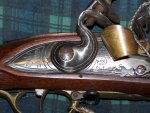Batjack
Cap`n Jack 1313
1st, been on Woody's for years, just on the "fish.n" forums. 2nd, I'm good with modern firearms, but when it comes to "smoke poles" my knowledge is that when I was a kid a Hawkins .50 was popular and that most have gone to in line (what ever that means) now.
My problem is that a friend "left" me the only two guns he owned, and I need to know what I've got. If it helps, he was HEAVY into Revolutionary War re-inactment and used these guns for it.
The small bore is thick walled .50 cal with no markings that I can find. The big one is thin walled and .75 cal with markings beside the hammer...behind "GRICE 1762" and in front what looks like a fancy mushroom or crown with "XXX" in the bottom and G.P. or G.R. under it. The barrel length on both is around 42 in. I hope the pics help. Thanks for any info.
My problem is that a friend "left" me the only two guns he owned, and I need to know what I've got. If it helps, he was HEAVY into Revolutionary War re-inactment and used these guns for it.
The small bore is thick walled .50 cal with no markings that I can find. The big one is thin walled and .75 cal with markings beside the hammer...behind "GRICE 1762" and in front what looks like a fancy mushroom or crown with "XXX" in the bottom and G.P. or G.R. under it. The barrel length on both is around 42 in. I hope the pics help. Thanks for any info.
Attachments
Last edited:




